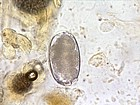Difference between revisions of "Category:Strongyloidea"
| Line 15: | Line 15: | ||
== General Life-Cycle == | == General Life-Cycle == | ||
| + | The life cycle of the strongyloids is typical of most nematodes. The L3 to adult development occurs in the large intestine where the L3 larvae penetrate the mucosal wall and form nodules. Some strongyle species larvae have a migratory life cycle in which they travel through body organs before returning to the large intestine of the host. | ||
| + | |||
*Like that of the trichostrongyloids (eggs are also 'typical strongyle eggs'), but: | *Like that of the trichostrongyloids (eggs are also 'typical strongyle eggs'), but: | ||
**L3 → L4 → adult (typically occurs in the large intestine) | **L3 → L4 → adult (typically occurs in the large intestine) | ||
Revision as of 10:28, 28 July 2010
General Appearance
Strongyloid nematodes share a a number of morphological features. They are bursate, meaning that the males have a copulatory bursa. They are realtively short, typically 1 - 5mm, but stout in appearance with a large buccal capsule at the anterior end. The head or anterior also usually carries characteristic features such as teeth or cutting plates.
General Life-Cycle
The life cycle of the strongyloids is typical of most nematodes. The L3 to adult development occurs in the large intestine where the L3 larvae penetrate the mucosal wall and form nodules. Some strongyle species larvae have a migratory life cycle in which they travel through body organs before returning to the large intestine of the host.
- Like that of the trichostrongyloids (eggs are also 'typical strongyle eggs'), but:
- L3 → L4 → adult (typically occurs in the large intestine)
- Larvae penetrate the mucosal wall and elicit nodule formation
- Larvae of some species migrate around the body
- Prepatent period varies between species from 3 weeks to over 6 months
Peritonitis in sheep by penetration of intestines by larvae of Oesophagostomum columbianum
Strongylus edentatus and Strongylus equinus migrate through Peritoneal Cavity - Parasitic Pathology
Stephanuris dentatus causes peritonitis in pigs Peritoneal Cavity - Parasitic Pathology and may cause cysts in the pancreas
Pages in category "Strongyloidea"
The following 6 pages are in this category, out of 6 total.
